Japanese ironclad Kōtetsu
Kōtetsu (甲鉄, literally "Ironclad"), later renamed Azuma (東, "East"), was the first ironclad warship of the Imperial Japanese Navy. She was built in Bordeaux, France, in 1864 for the Confederate States Navy under the cover name Sphinx and commissioned as CSS Stonewall. Japan acquired her from the United States in February 1869. She was designed as an armored ram but also carried three guns. She had a decisive role in the Naval Battle of Hakodate Bay in May 1869, which marked the end of the Boshin War, and the completion of the military phase of the Meiji Restoration.
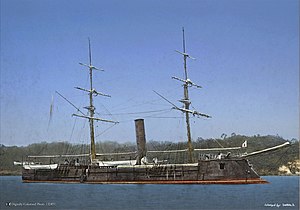 Azuma at anchor in Yokosuka, c. 1878–1879 | |
| History | |
|---|---|
| Name: | Kōtetsu |
| Builder: | Arman Brothers, Bordeaux, France |
| Laid down: | 1863 |
| Launched: | 21 June 1864 |
| Acquired: | 3 February 1869 |
| Commissioned: | 25 October 1864 |
| Decommissioned: | 28 January 1888 |
| Honours and awards: | Azuma, 1871 |
| Fate: | Sold for scrap, 12 December 1889 |
| General characteristics | |
| Class and type: | Ironclad ram |
| Displacement: | 1,390 long tons (1,410 t) |
| Length: | 186 ft 9 in (56.9 m) (o/a) |
| Beam: | 32 ft 6 in (9.9 m) |
| Draft: | 14 ft 3 in (4.3 m) |
| Installed power: | |
| Propulsion: | 2 shafts; 2 direct-acting steam engines |
| Sail plan: | Brig rigged |
| Speed: | 10.5 knots (19.4 km/h; 12.1 mph) |
| Range: | 3,000 nmi (5,600 km; 3,500 mi) |
| Complement: | 135 |
| Armament: |
|
| Armor: |
|
Description
Sphinx was 165 feet 9 inches (50.5 m) long between perpendiculars and had an overall length of 186 feet 9 inches (56.9 m) including her prominent pointed naval ram. The ship had a beam of 32 feet 6 inches (9.9 m) and a draught of 14 feet 3 inches (4.3 m).[Note 1] The brig's composite hull was sheathed in copper to protect it from parasites and biofouling and it featured a pronounced tumblehome. She displaced 1,390 long tons (1,410 t) and her crew numbered 135 officers and crewmen.[1]
The main battery consisted of a single 300-pound muzzle-loading Armstrong gun (27.9 cm) located on the bow in a single mount. This gun fired a shell weighing 136 kg. A 70-pound Armstrong muzzle-loading rifle (12.7 cm) was mounted on the center of the hull with a single mount on each side. This gun could fire shells weighing 32 kg. However, the performance of these guns were poor, and they were later replaced in 1871 with four US-made Parrott rifles. The guns were on movable mounts to allow them to fire through the different firing ports.
In terms of armor, the ship was designed with the goal of withstanding hits by 15-inch guns. The gun mounts were in casemates which extended in wide ellipse to the front and rear in a complicated curve, and which had a thickness of 102 mm to 140 mm, which was bolted on top of an 80 mm thickness of cushioning material. The hull was protected by a wrought iron armored belt extending 1.5 meters above the waterline and 1.2 meters below. The hull armor was 125 mm thick in the center, tapering to 90 mm towards the bow and stern.
The power plant consisted of a pair of Mazeline horizontal two-cylinder single-expansion steam engines, each driving one propeller shaft using steam provided by two Mazeline tubular boilers. The engines were rated at a total of 1,200 PS (1,184 ihp). Each shaft drove a four-bladed screw that was 3.6 m (11 ft 10 in) in diameter, and was tilted at an angle of 45 degrees to the propulsion shaft. This ship exhibited a maximum speed of 10.8 knots (20.0 km/h; 12.4 mph) knots in a public trials and a practical speed of 10.5 knots. She had a range of 1,200 nautical miles (2,200 km; 1,400 mi) at 9 knots (17 km/h; 10 mph) with a full load of 200 t (197 long tons) of coal.
Origins
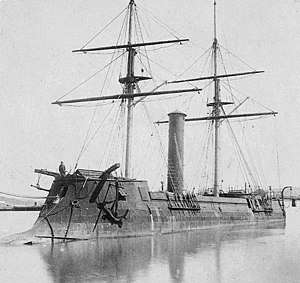
In June 1863 John Slidell, the Confederate commissioner to France, asked Emperor Napoleon III in a private audience if it would be possible for the Confederate government to build ironclad warships in France. Arming ships of war for a recognized belligerent like the Confederate States would have been illegal under French law, but Slidell and Confederate agent James D. Bulloch were confident that the Emperor of France would be able to circumvent his own laws more easily than other potential secret contractors. Napoleon III agreed to the building of ironclads in France on the condition that their destination remain a secret.[2] The following month Bulloch entered a contract with Lucien Arman, an important French shipbuilder and a personal confidant of Napoleon III, to build a pair of ironclad rams capable of breaking the Union blockade. To avoid suspicion, the ships' guns were manufactured separately from the ship herself and the pair were named Cheops and Sphynx to encourage rumors that they were intended for the Egyptian Navy.[3]
Prior to delivery, however, a shipyard clerk walked into the U.S. Minister's office in Paris and produced documents which revealed that Arman had fraudulently obtained authorization to arm the ships and was in contact with Confederate agents.[4] The French government blocked the sale under pressure from the United States, but Arman was able to sell the ships illegally to Denmark and Prussia, which were then fighting on opposite sides of the Second Schleswig War. Cheops was sold to Prussia as Prinz Adalbert, while Sphynx was sold to Denmark under the name Stærkodder.
Manned by a Danish crew, the ship left Bordeaux for its shakedown cruise on June 21, 1864. The crew tested the vessel while final negotiations were being conducted between the Danish Naval Ministry and L'Arman. Intense haggling over the final price and a disagreement over compensation from Arman for cited problems and late delivery led to negotiations breaking down on October 30. The Danish government refused to relinquish the vessel, claiming confusion in regards to the negotiations.[5][6]
American career as CSS Stonewall
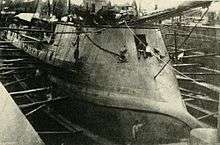
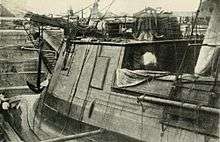
On January 6, 1865 the vessel took on a Confederate crew at Copenhagen under the command of Captain Thomas Jefferson Page, CSN[7] and was recommissioned CSS Stonewall while still at sea.[5]
The arrival of the "formidable" Stonewall in America was dreaded by the Union, and several ships tried to intercept her, among them USS Kearsarge and USS Sacramento. Stonewall sprang a leak, however, after picking up supplies and additional crew at Quiberon, Brittany and Captain Page made for Spain in order to undertake repairs. In February and March, USS Niagara and Sacramento kept watch from a distance as Stonewall lay anchored off A Coruña during February 1865. On March 24 Captain Page put out to sea, challenging the U.S. Navy vessels, which turned and fled, fearful of engaging the ironclad. Finding that the enemy had run, Captain Page steamed for Lisbon, intending to cross the Atlantic Ocean from there and attack at Port Royal, South Carolina, the base of Major General Sherman's attack on South Carolina.[7]
Stonewall reached Nassau on May 6, and then sailed on to Havana, Cuba, where Captain Page learned of the war's end. There he decided to turn her over to the Spanish Captain General of Cuba for the sum of $16,000.[8] The vessel was then turned over to United States authorities in return for reimbursement of the same amount.[9] She was temporarily de-commissioned, stationed at a U.S. Navy dock, until she was offered for sale to the Japanese government of the Tokugawa shogunate.
Japanese career
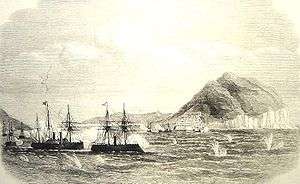
Acquisition
In 1867, acting envoy Ono Tomogoro of the Tokugawa shogunate of Japan made a formal offer to the United States government for the purchase of the USS Stonewall to reinforce the ongoing modernization of its army and navy. He made a payment of US$30,000 in advance, with the remaining US$10,000 to be paid on delivery. The ship was renamed Kōtetsu, and arrived in Shinagawa port in April 1868,[10] However, by the time of her arrival, the Boshin War between the shogunate and pro-Imperial forces had begun, and the United States took a neutral stance, which included stopping the delivery of military material, including the delivery of Kōtetsu, to the Shogunate. The ship had actually arrived under a Japanese flag, but US Resident-Minister Robert B. Van Valkenburg ordered her put back under the American flag on arrival in Japan with a caretaker crew of the US naval squadron then stationed there.[11] Kōtetsu was finally delivered to the new Meiji government in February 1869.
Boshin War
In the meantime, Tokugawa admiral Enomoto Takeaki refused to surrender his warships after the surrender of Edo Castle to the new government, and escaped to Hakodate in Hokkaido with the remainder of the Tokugawa Navy and a handful of French military advisers and their leader Jules Brunet. His fleet of eight steam warships was the strongest in Japan at the time. On 27 January 1869, Tokugawa loyalists declared the foundation of the Republic of Ezo and elected Enomoto as president. The Meiji government refused to accept partition of Japan and dispatched its newly formed Imperial Japanese Navy, which consisted of Kōtetsu and a collection of various steam-powered warships that had been contributed by the various feudal domains loyal to the new government. On March 25, 1869, in the Naval Battle of Miyako Bay, Kōtetsu successfully repulsed a surprise night attempt at naval boarding by the rebel Kaiten (spearheaded by survivors from the Shinsengumi), making use of a mounted Gatling gun.[10] Kōtetsu subsequently supported the invasion of Hokkaidō and various naval engagements in the Naval Battle of Hakodate Bay.
Subsequent career
Following the end of the Boshin War, in August 1870, Kōtetsu was classified as a third-class warship on 15 November 1871. She was renamed Azuma on 7 December. By January 1873, her fighting ability was assessed as low.[12] Azuma was assigned to guard Nagasaki during the Saga rebellion in February 1874 and in the Taiwan Expedition of May 1874. On 19 August she ran aground at Kagoshima during a typhoon, but was refloated and repaired at the Yokosuka Naval Arsenal. During the Satsuma Rebellion of 1877, she was assigned to guard duties in the Seto Inland Sea. She was stricken from the navy list on 28 January 1888, and was sold for scrap.[10] Her armor plating was reused to make the armature shafts in the electric generators in the Asakusa Thermal Power Station, built in Tokyo in 1895.[13]
Notes
- Published data for the ship's specifications vary considerably, but Silverstone and Canney are assumed to be the most accurate as the US Navy surveyed the ship after the war and have been used here.Jentschura, Jung & Mickel, p. 12; Lengerer, pp. 118–119
Citations
- Canney, pp. 113–114; Silverstone, p. 150
- Case and Spencer, pp. 429–433
- Case and Spencer, pp. 435–439
- Case and Spencer, pp. 437–439.
- Steensen, Robert Steen. Vore Panserskibe [Our Armoured Vessels]. Marinehistorisk Selskab, Copenhagen, Denmark: 1968. pp. 178–195. Steensen was a former Commander in the Royal Danish Navy. An English translation by Søren Nørby may be found at http://milhist.dk/vabnet/the-armoured-ram-staerkodder/
- Both the Stærkodder and Stonewall commissionings can be considered valid through international maritime law as illustrated by Captain Thomas J. Page; "customarily, a ship is held to be commissioned when a commissioned officer appointed to her has gone on board of her and hoisted the colors appropriated to the military marines." Page, Thomas J. "The Career of the Confederate Cruiser Stonewall". Southern Historical Society Papers, Volume VII, Number 6. Richmond, Virginia: 1879. Pages 263–280
- Schafer, p. 805.
- Schafer, p. 806.
- Letter from William H. Seward to Gideon Wells, July 18, 1865. A copy may be found in the Official Records of the Union and Confederate Navies. Volume 3, page 566.
- Letter from Susumu Nishiura, Staff-in-Chief, War History Room, Ministry of Defense, Japan, to Faith Kravitz, Eleutherian Mills, Hagley Museum, Delaware, USA dated Sept. 25, 1965, available at https://archive.org/details/KravitzNishiuraLtrJapanese/
- Free, Early Japanese Railways 1853–1914: Engineering Triumphs That Transformed Meiji-era Japan, Tuttle Publishing, 2008 (ISBN 4805310065) at p. 35
- Lengerer, p. 118
- Lengerer, p. 119
References
- End of the Bakufu and Restoration in Hakodate 函館の幕末・維新 (Japanese). ISBN 4-12-001699-4.
- Canney, Donald L. (2015). The Confederate Steam Navy 1861–1865. Atglen, Pennsylvania: Schiffer Publishing. ISBN 978-0-7643-4824-2.
- Case, Lynn M. & Spencer, Warren F. (1970). The United States and France: Civil War Diplomacy. Philadelphia, Pennsylvania: University of Pennsylvania Press. OCLC 251911277.
- Jentschura, Hansgeorg; Jung, Dieter & Mickel, Peter (1977). Warships of the Imperial Japanese Navy, 1869–1945. Annapolis, Maryland: United States Naval Institute. ISBN 0-87021-893-X.
- Lengerer, Hans (2020). "The Kanghwa Affair and Treaty: A Contribution to the Pre-History of the Chinese–Japanese War of 1894–1895". Warship International. International Naval Research Organization. LVII (2): 110–131. ISSN 0043-0374.
- Olmstead, Edwin; Stark, Wayne E.; Tucker, Spencer C. (1997). The Big Guns: Civil War Siege, Seacoast, and Naval Cannon. Alexandria Bay, New York: Museum Restoration Service. ISBN 0-88855-012-X.
- Scharf, J. Thomas (1977). History of the Confederate States Navy From its Organization to the Surrender of its Last Vessel (Reprint of the 1887 ed.). New York: Fairfax Press. ISBN 0-51723-913-2.
- Silverstone, Paul H. (2006). Civil War Navies 1855–1883. The U.S. Navy Warship Series. New York: Routledge. ISBN 0-415-97870-X.
- Still, William N., Jr. (1985) [1971]. Iron Afloat: The Story of the Confederate Armorclads. Columbia, South Carolina: University of South Carolina Press. ISBN 0-87249-454-3.
- Watts, A. J. (1979). "Japan". In Chesneau, Roger & Kolesnik, Eugene M. (eds.). Conway's All the World's Fighting Ships 1860–1905. Greenwich, UK: Conway Maritime Press. pp. 216–239. ISBN 0-8317-0302-4.
External links
| Wikimedia Commons has media related to Azuma (ship, 1864). |
- CSS Stonewall (1865) Photos and engravings at sea, anchor, one possibly as Azuma
- CSS Stonewall (1865) At Washington, D.C., 1865-1867 Photos at Washington Navy Yard
- C.S.S. Stonewall History and photos, including one colorized as Azuma
- FS Sphynx / CSS Stonewall Ocean-Going Ironclad Ram (1864) History and photos